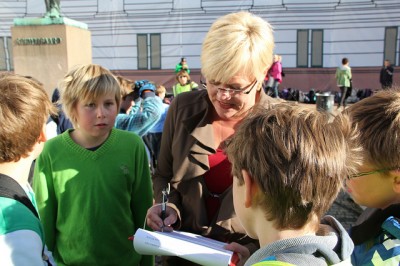Finally some good news for Education Minister Kristin Halvorsen: After years of seeing Norwegian students fall behind in international test scores, she could finally show off some new testing results that show progress in math, science and reading.

“All the negative trends are reversed,” Halvorsen proudly proclaimed after releasing results this week from two sets of testing. The TIMSS (Trends in Mathematic and Science Study) and PIRLS (Progress in Readng Literacy Study) results both showed a continuous upturn since 2007.
Both tests are aimed at fourth grade students, with the math and science testing also done of students up to the 8th grade in 52 countries around the world. Norway took part in the TIMSS testing in 1995, 2003 and 2007, and in PIRLS in 2001, 2006 and 2011.
“Norwegian students in the fourth grade are world champions in progress,” Halvorsen also claimed, clearly proud and relieved to show improved results after earlier years of decline. She said that teachers and principals “know that what we’re doing works.”
That often centers on “lifting up the weakest,” but Halvorsen still must fend off criticism that Norwegian schools don’t inspire the most clever students. It’s traditionally been objectionable in Norwegian schools to divide students by their ability, meaning that the best students often get bored or aren’t challenged enough. “The fact that good students are bored to tears during math lessons is as bad as dealing with those who don’t understand a thing,” Simen Smestad, an 8th grade teacher at Nordberg School in Oslo.
And even though students are showing better test results, they’re still only average, even slightly below, according to world rankings. The average score in the TIMSS study was 500, for example, with Norwegian 4th graders scoring 495 and ranked 29th in the world. Norwegian students didn’t come close to breaking into the top five, or even the top 10 in any category. The top spots were held by students in Hong Kong, Singapore and South Korea, with Norwegian fourth-graders ranking 31st in reading, 8th-graders 20th in math, and 4th and 8th graders 33rd and 19th in science respectively.
“The scores were better, but still not good enough,” Liv Sissel Grønmo, leader of the Norwegian TIMSS testing, told newspaper Dagens Næringsliv (DN).
Views and News from Norway/Nina Berglund
Please support our news service. Readers in Norway can use our donor account. Our international readers can click on our “Donate” button:

